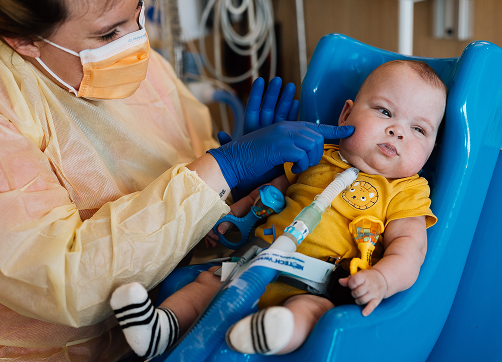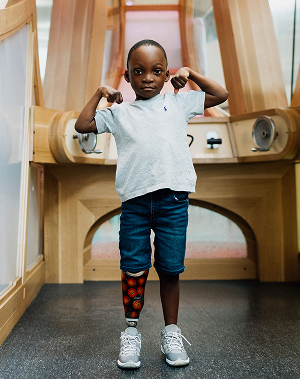auriculo condylar syndrome


about condition
Auriculo-condylar syndrome, also known as Question-mark ear syndrome, is a genetic condition present at birth. This syndrome particularly affects the development of the face, ears and lower jaw (mandible).
Most individuals with auriculo-condylar syndrome have the hallmark distinctive outer ear malformation (“auriculo” refers to the ears) in the shape of a question-mark. A split that separates the upper part of the ear from the earlobe is what causes the question-mark shape. Other known ear shape malformations include ears that rotate back, cupped ears, or ears with fewer folds and grooves than the typical ear. Narrow ear canals, small skin tags in front or behind the ear, as well as hearing loss can also be associated with this syndrome.
Malformations of the mandible are another characteristic feature of this condition. This includes an unusually small jaw (micrognathia) and the malfunction of the temporomandibular joint (TMJ). The TMJ is what connects the lower jaw to the skull. Problems with the TMJ can affect how the upper and lower jaws fit together, making it difficult to open and close the mouth. The other part of the syndrome name “condylar” refers to the mandibular condyle, which is the upper portion of the mandible that forms part of the TMJ.
Auriculo-condylar syndrome varies among affected individuals, even between affected family members.
Possible symptoms and characteristics may include:
- Hallmark ear shape in the form of a question-mark
- Cupped ears
- Ears without the typical folds/grooves (simple ears)
- Ears that rotate back
- Prominent cheekbones
- Cleft palate
- Unusually small mouth (microstomia)
- Small lower jaw
- Small chin
Facial structures differing in size/shape (facial asymmetry)
- Eating difficulties
- Airway issues
*Surgical intervention may include jaw distraction and cleft palate procedures to improve functions early on, as well as other necessary procedures
how do I know if my child will be born with Auriculo-condylar syndrome?
Sometimes when an ultrasound is performed during pregnancy, a doctor may notice non-typical signs which require additional testing. More in-depth testing with 2D or 3D ultrasounds or a fetal MRI can reveal much more detail. After birth, clinical examinations, CT scans, genetics and other testing can help to diagnose the syndrome.
If one of the parents is affected, during the pregnancy more in-depth testing can be done to possibly rule out the syndrome. For genetic purposes, it is helpful if the affected parent has already been tested and their positive mutation change ‘location’ has been found. The location is the area in the gene where the positive mutation change occurs. A good way to think about this is finding a letter typo on a page within a book; that’s the exact location. Therefore, if the affected parent has received their mutation change information from their genetics department, it will be straightforward to look in the exact same location in the DNA of the fetus to find or rule out a positive mutation. In dominant genetic conditions, positive mutations appear in the same location (same page letter typo) for all family members having the condition, even if affected family members have varying expressions. Genetic counseling is highly recommended for any individual with Auriculo-condylar syndrome having or considering a future family. If a mutation change is found, always retain a copy of the genetics report from the genetics department for safekeeping.


how do you treat this condition?
The treatment of Auriculo-condylar syndrome is focused on the specific symptoms apparent in each individual since the symptoms vary. Several specialties and physicians may be involved throughout the child’s life. Surgeries such as craniofacial and reconstructive procedures may be necessary to correct airway issues, and possibly additional surgeries to correct other craniofacial malformations. Patients may see some or all of the following physician specialties: craniofacial surgeon, otolaryngologist (ENT), pulmonologist, audiologist, ophthalmologist, dentist, orthodontist, oral surgeon, and more.
faqs
Research indicates this syndrome is very rare; only around 1000 occurrences are estimated.
Yes, this syndrome is usually apparent at birth. It is a genetic autosomal dominant condition, which means it can either be inherited from one parent or occur as a result of a new sporadic mutation change in a gene. Any affected individual will have a 50% chance of passing the syndrome on to future children.
Although surgeries may be in their future, affected individuals should have a typical life span.
Genetic mutation changes in either of these two genes, GNAI3 or PLCB4, are currently known to cause this syndrome.
This syndrome can be caused by a genetic mutation change in either of the GNAI3 or PLCB4 genes. These genes provide instructions for making proteins that are involved in chemical signaling within cells. They help transmit information from outside the cell to inside the cell, which instructs the cell to grow, divide, or take on specialized functions.
Studies suggest that the proteins produced from these genes contribute to the development of the first and second pharyngeal arches, which are structures in the embryo that ultimately develop into the jawbones, facial muscles, middle ear bones, ear canals, outer ears, and related tissues. Mutation changes in these genes alter the formation of the lower jaw. Instead of developing typically, the lower jaw becomes shaped more like the smaller upper jaw (maxilla). This malformed shape leads to the smaller jaw and problems with TMJ function. Researchers are working to determine how a mutation change in these genes lead to the other developmental malformations associated with auriculo-condylar syndrome.
Additionally, in some affected individuals with auriculo-condylar syndrome, a mutation in the GNAI3 or PLCB4 gene has not been found. Until further discovery, the cause of the condition in these individuals will remain unknown.
- Auriculocondylar syndrome
- Dysgnathia complex
- Question-mark ear syndrome
- Treacher Collins syndrome (characteristics can be similar and misdiagnosed in early stages)
here when you need us
Whether you’re looking for the right provider, ready to make an appointment, or need care right now—we’re here to help you take the next step with confidence.
